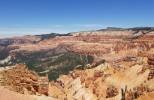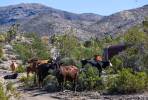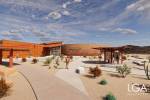Air Force, fossil fans say hold power line
With their fossilized bones poking from the chalky, beige soil, the animals that roamed what is now the Mojave Desert during the ice ages lie quietly where they died, unaware of civilization growing toward the edge of their graves.
Instead of lush plants that Columbian mammoths would munch while standing knee-deep in bubbling springs, the landscape is dotted with shrubs: creosote, buckwheat and bearpoppy plants.
Helicopters routinely thunder overhead on training missions from Nellis Air Force Base to the range near Creech Air Force Base, 45 miles northwest of Las Vegas.
The helicopters skirt a safe distance over power transmission lines that transect the 23,000-acre area conservationists hope to protect.
To the south, the sprawl of the Las Vegas Valley ends in frontage roads and dead-end streets.
To the north, the view is a raw stretch of the Mojave that flanks Desert National Wildlife Refuge, climbing to the chiseled ridges of the Sheep Mountains.
It is that view, as much as the undisturbed soil of the prehistoric cemetery, that Protectors of Tule Springs and the National Parks Conservation Association want to keep for tourists to see and for scientists to study. They expect the Nevada delegation to introduce a bill preserving the Upper Las Vegas Wash as a national monument when Congress reconvenes .
The U.S. Air Force also favors monument status, which would block construction of an NV Energy-proposed power line that would carry electricity from Amargosa Valley solar projects but also present a hazard to helicopters and low-flying warplanes.
"The way we see it, this is an opportunity to preserve two national treasures, one on the ground and the other in the air," said Deborah MacNeill, director of public partnerships for Nellis and Creech.
With dozens of renewable energy projects planned beneath the 12,000-square-mile airspace for the 2.9 million-acre Nevada Test and Training Range, the Air Force held an informational forum last month.
They wanted to let land managers and the renewable energy industry know that glare from mirrors and solar towers, and radar images from whirling wind turbines can interfere with aircraft navigation and targeting.
A new, higher-elevation transmission line across the proposed national monument site would further complicate matters, they say.
"It just seems like we're asking for a tragic accident," MacNeill said on a visit to the site last week.
Afterward, the North Las Vegas City Council authorized the city attorney to intervene in any action before the Public Utilities Commission of Nevada concerning NV Energy's transmission line.
In a statement Friday, NV Energy officials said they will continue to work with local governments and national monument proponents.
"The utility's current proposal allows for the co-existence of both the national monument area and NV Energy's transmission lines, while minimizing the impact to valuable resources in the Upper Las Vegas Wash," said Chelsie Campbell, senior representative for NV Energy's corporate communications.
She said the transmission lines are critical for solar development in the Amargosa Valley "and for future access to renewable resources along the western part of the state."
The lines would parallel ones already in place.
Lynn Davis, Nevada field office manager for the National Parks Conservation Association, said she hopes NV Energy's last-minute request will be dismissed by Sept. 13 so that national monument legislation can be introduced in the House and Senate.
Davis said if NV Energy is allowed to proceed, work would have to halt every time crews come across fossils from mammoths, North American jaguars, camels, bison, bears, sloths and other ancient animals in order to conduct costly and time-consuming paleontological digs.
Hundreds of fossils were documented when three-dozen poles were installed for the existing transmission line.
"You can expect that could be tied up for years," Davis said. "NV Energy predicts six to 10 years to build transmission lines, and during that time you'd be up here watching bulldozers."
A better alternative would be a transmission line along the Las Vegas Beltway, she said.
Tule Springs captured international acclaim in 1962, when scientists uncovered a variety of ancient animal fossils dating from 11,000 to 40,000 years ago.
Later studies indicated some fossils in the area might be 200,000 years old.
Researchers now hope the rich fossil beds will yield clues to climate change and arid conditions that might have helped cause the demise of the mammoth.
Contact reporter Keith Rogers at
krogers@reviewjournal.com or 702-383-0308.





























